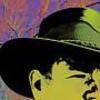Rule of Thumb on selecting ISO
Jul 17, 2012 11:09:08 #
Brad
Loc: Middletown, Pennsylvania
Is there a rule of thumb on choosing a particular ISO over another?
Low light? Bright light? Overcast? No light? Inside, etc.?
I know you can't give me exact ISO to use, but what about a starting point, a general idea.
Thank you in advance for your help/
Low light? Bright light? Overcast? No light? Inside, etc.?
I know you can't give me exact ISO to use, but what about a starting point, a general idea.
Thank you in advance for your help/
Jul 17, 2012 11:22:47 #
The rule of thumb is to use the nominal ISO for your camera. This is usually 100 for most cameras and 200 for some Nikons.
If you are in dark conditions to the point that you need too slow a shutter speed and/or too wide an aperture, increase the ISO to the minimum value that gets you the shutter speed and aperture you need.
If you are in dark conditions to the point that you need too slow a shutter speed and/or too wide an aperture, increase the ISO to the minimum value that gets you the shutter speed and aperture you need.
Jul 17, 2012 11:35:50 #
PrairieSeasons wrote:
Good answer! :thumbup:The rule of thumb is to use the nominal ISO for your camera. This is usually 100 for most cameras and 200 for some Nikons.
If you are in dark conditions to the point that you need too slow a shutter speed and/or too wide an aperture, increase the ISO to the minimum value that gets you the shutter speed and aperture you need.
If you are in dark conditions to the point that you need too slow a shutter speed and/or too wide an aperture, increase the ISO to the minimum value that gets you the shutter speed and aperture you need.
Jul 17, 2012 14:33:44 #
Festina Lente wrote:
PrairieSeasons wrote:
Good answer! :thumbup:The rule of thumb is to use the nominal ISO for your camera. This is usually 100 for most cameras and 200 for some Nikons.
If you are in dark conditions to the point that you need too slow a shutter speed and/or too wide an aperture, increase the ISO to the minimum value that gets you the shutter speed and aperture you need.
If you are in dark conditions to the point that you need too slow a shutter speed and/or too wide an aperture, increase the ISO to the minimum value that gets you the shutter speed and aperture you need.
Or, if in manual, use auto ISO and then select your shutter and aperture.
Jul 17, 2012 14:36:41 #
PrairieSeasons wrote:
The rule of thumb is to use the nominal ISO for your camera. This is usually 100 for most cameras and 200 for some Nikons.
If you are in dark conditions to the point that you need too slow a shutter speed and/or too wide an aperture, increase the ISO to the minimum value that gets you the shutter speed and aperture you need.
If you are in dark conditions to the point that you need too slow a shutter speed and/or too wide an aperture, increase the ISO to the minimum value that gets you the shutter speed and aperture you need.
Correct! That's what all the books and the experts will tell you, too.
Jul 17, 2012 15:53:44 #
traveler90712 wrote:
Or, if in manual, use auto ISO and then select your shutter and aperture.
I recommend that you NEVER use auto ISO (unless all shutter and apertaure options have been exhausted.) Festina Lente wrote:
PrairieSeasons wrote:
Good answer! :thumbup:The rule of thumb is to use the nominal ISO for your camera. This is usually 100 for most cameras and 200 for some Nikons.
If you are in dark conditions to the point that you need too slow a shutter speed and/or too wide an aperture, increase the ISO to the minimum value that gets you the shutter speed and aperture you need.
If you are in dark conditions to the point that you need too slow a shutter speed and/or too wide an aperture, increase the ISO to the minimum value that gets you the shutter speed and aperture you need.
Or, if in manual, use auto ISO and then select your shutter and aperture.
From a pratical standpoint, it is a bad idea. High ISOs will affect the quality of your image more than shutter speed and aperature.
Jul 17, 2012 18:13:14 #
Jul 17, 2012 18:15:56 #
if you are not full frame, be very careful when playing with this setting. It can make or break a good shot
Jul 18, 2012 05:49:29 #
I am not a fan of auto ISO, but then I sometimes overestimate how steadily I can hand hold a shot. For many subjects where I can shoot several times, I do until I get a steady shot. I am patient, use meditative breathing, triangular holding, and any other nearby post, pole, fence, mailbox, et cetera to stabilize. I actually managed a respectable longish exposure (1/6 second) with my 105 macro with VR on rapids that way. A nearby tree was used to help stabilize the camera--I pushed the base of the camera onto the side of the tree, used mirror up, and gently depressed the shutter at the trough of my out breath.
See http://www.flickr.com/photos/zero_equals_infinity/7555047834/meta/in/photostream
See http://www.flickr.com/photos/zero_equals_infinity/7555047834/meta/in/photostream
Jul 18, 2012 10:42:36 #
wtw2143
Loc: West Hempstead, NY
Festina Lente wrote:
Very good answer, absolutely agree ! quote=traveler90712 quote=Festina Lente quote=P... (show quote)
:thumbup: :thumbup:
Jul 18, 2012 11:08:16 #
Jul 18, 2012 11:17:31 #
Festina Lente wrote:
PrairieSeasons wrote:
Good answer! :thumbup:The rule of thumb is to use the nominal ISO for your camera. This is usually 100 for most cameras and 200 for some Nikons.
If you are in dark conditions to the point that you need too slow a shutter speed and/or too wide an aperture, increase the ISO to the minimum value that gets you the shutter speed and aperture you need.
If you are in dark conditions to the point that you need too slow a shutter speed and/or too wide an aperture, increase the ISO to the minimum value that gets you the shutter speed and aperture you need.
I will second this answer :thumbup: :thumbup:
Jul 18, 2012 11:17:39 #
As far as ISO, I generally look at several things in my head when I pick.
First off, the lowest ISO is the highest quality as far as grain and noise. So it's always my preference, however, shooting conditions and needs might cause me to have to compromise with a higher ISO.
Next, I think about lighting. if it's low light, then I know I'll have to pick ISO 800 or higher.
Next, if light permits a low ISO like 100 or 200, then I look at what I'm photographing. If it's sports where I would need a fast shutter, and/or if I know I want a good DOF (hence the need for an aperture of f/8 or f/16 or higher), then I might also have to up the ISO in order to accomodate that need.
So I wouldn't say there's a rule of thumb. There isn't going to be a one-size-fits-all rule of thumb. It's going to be a series of decisions you make based upon your needs.
First off, the lowest ISO is the highest quality as far as grain and noise. So it's always my preference, however, shooting conditions and needs might cause me to have to compromise with a higher ISO.
Next, I think about lighting. if it's low light, then I know I'll have to pick ISO 800 or higher.
Next, if light permits a low ISO like 100 or 200, then I look at what I'm photographing. If it's sports where I would need a fast shutter, and/or if I know I want a good DOF (hence the need for an aperture of f/8 or f/16 or higher), then I might also have to up the ISO in order to accomodate that need.
So I wouldn't say there's a rule of thumb. There isn't going to be a one-size-fits-all rule of thumb. It's going to be a series of decisions you make based upon your needs.
Jul 18, 2012 11:21:44 #
Your ISO setting can become very important if you need a fast shutter speed in lower light situations. If you need a high shutter speed to stop moving/action shot but the available light limits the shutter speed to less than the focal length (shutter speed 100, focal length 200 or 300) you will get a blurry shot. With the new mid to higher end DSLR's out there now you can push the ISO to 5 or 6000 which will allow the faster shutter and get completely usable images, with only moderate noise, and if printing smaller prints, noise that is practically unnoticeable. Can you get a little noise, yes, but is the picture worth a little noise, and are you likely to be submitting it for the cover of National Geographic? Now days, a good lens, good camera, high ISO, good noise reduction in camera and via software, pretty much allows you to shoot in the dark. JMHO. novots.
Jul 18, 2012 12:11:02 #
Hello
On my Canon 7D I start my ISO at 160 and double it when needed. Yours may be the same or different check it out!
On my Canon 7D I start my ISO at 160 and double it when needed. Yours may be the same or different check it out!
Brad wrote:
Is there a rule of thumb on choosing a particular ISO over another?
Low light? Bright light? Overcast? No light? Inside, etc.?
I know you can't give me exact ISO to use, but what about a starting point, a general idea.
Thank you in advance for your help/
Low light? Bright light? Overcast? No light? Inside, etc.?
I know you can't give me exact ISO to use, but what about a starting point, a general idea.
Thank you in advance for your help/
If you want to reply, then register here. Registration is free and your account is created instantly, so you can post right away.









